Rome, the Eternal City, is an open-air museum boasting millennia of history, art and culture. From ancient monuments that shaped human history to timeless works of art, every corner of this city has a story to tell. If you are planning a visit, here are 20 attractions must-haves that should be on your list:
The Colosseumalso known as the Flavian Amphitheatre, is the undisputed symbol of Rome and one of the most iconic structures to the world. This imposing building, erected in the 1st century A.D. under the empire of Vespasian and completed by his son Titus, has been the scene of spectacular events that have fascinated mankind for centuries.
Imagine yourself among the ruins of this amphitheatresurrounded by the ghosts of gladiators, exotic beasts and naval spectacles. The Colosseum was not just a simple arena; it was a symbol of Roman power and engineeringcapable of seating up to 80,000 spectators in an era without modern communication or transport systems. This extraordinary monument was the centre of social and economic life in ancient Rome, offering free entertainment ranging from gladiator fights to hunting shows and dramas based on Roman mythology.
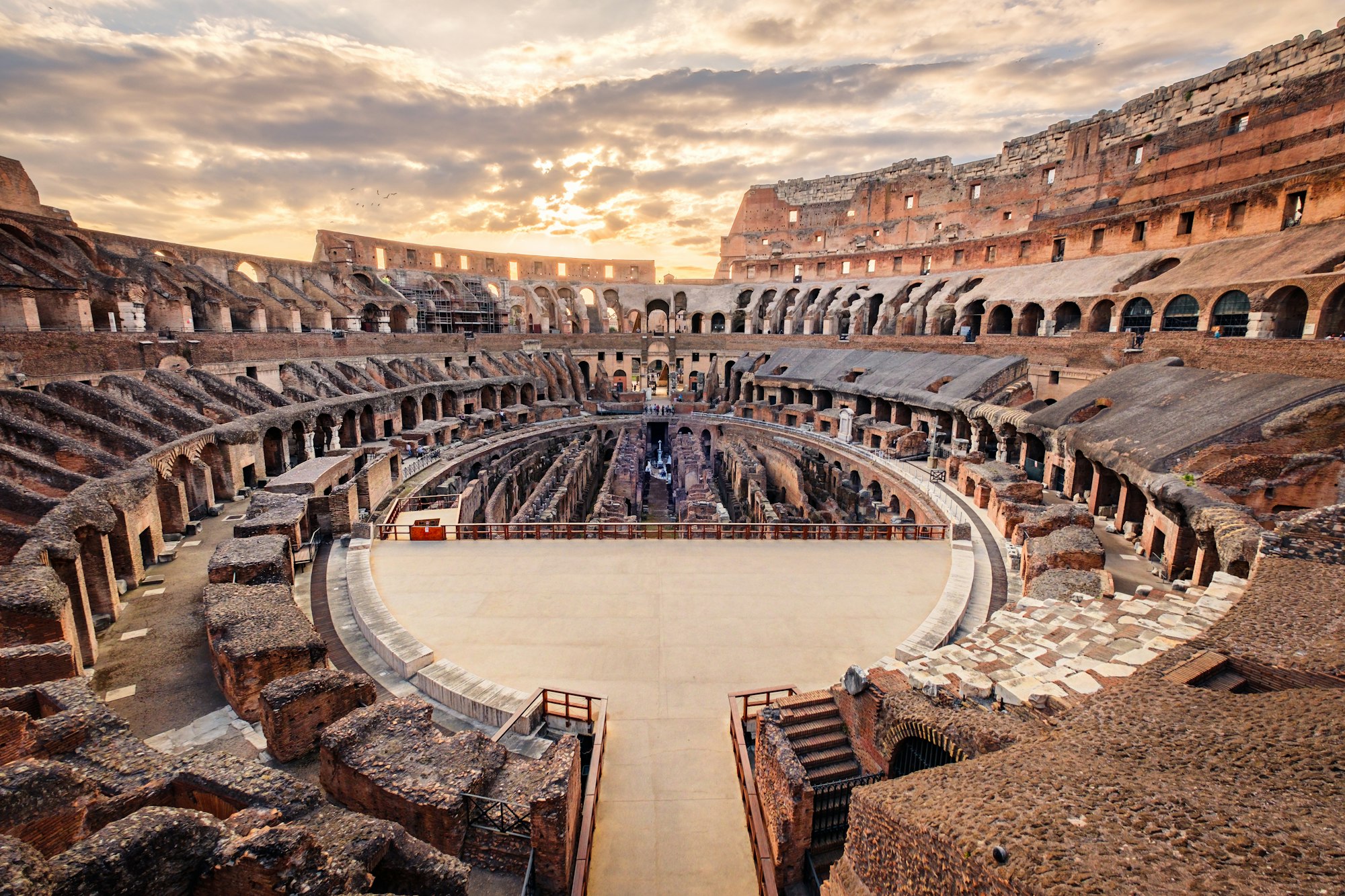
Photo of the Colosseum inside at sunset
Over the years, the Colosseum has suffered much damage from earthquakes, looting and the neglect of time, but it still stands, imposing, as a testament to the greatness of Rome. Today, it is a UNESCO World Heritage Site and one of the sights most visited in the world, attracting millions of visitors who wish to stroll through its arches and breathe in the history that permeates every stone.
The importance of the Colosseum goes far beyond its physical structure; it represents the pinnacle of the Roman culture and architectureand a permanent reminder of human genius and its ability to create, entertain, dominate, but also to destroy. A visit to this legendary monument offers a unique immersion into the life of the ancient Romans, allowing one to experience the greatness and at the same time the fragility of human civilisation.
The Roman Forum was the nerve centre of the Ancient Romea place where politics, religion and sociality were inextricably intertwined in daily life. Located in the valley between the Palatine Hill and the Capitoline Hill, this public space housed some of the most important buildings of the time, including basilicas, temples and memorials that saw the history of the Republic and Empire unfold between their columns.
To walk through the Roman Forum is to walk the same stones that saw senators, citizens and slaves go about their daily lives, negotiate political alliances, worship the gods and celebrate military victories. This is where historical figures such as Julius Caesar, Augustus and Marcus Aurelius left their mark, and where Roman democracy took shape through intense debates and decisions that influenced the course of Western history.
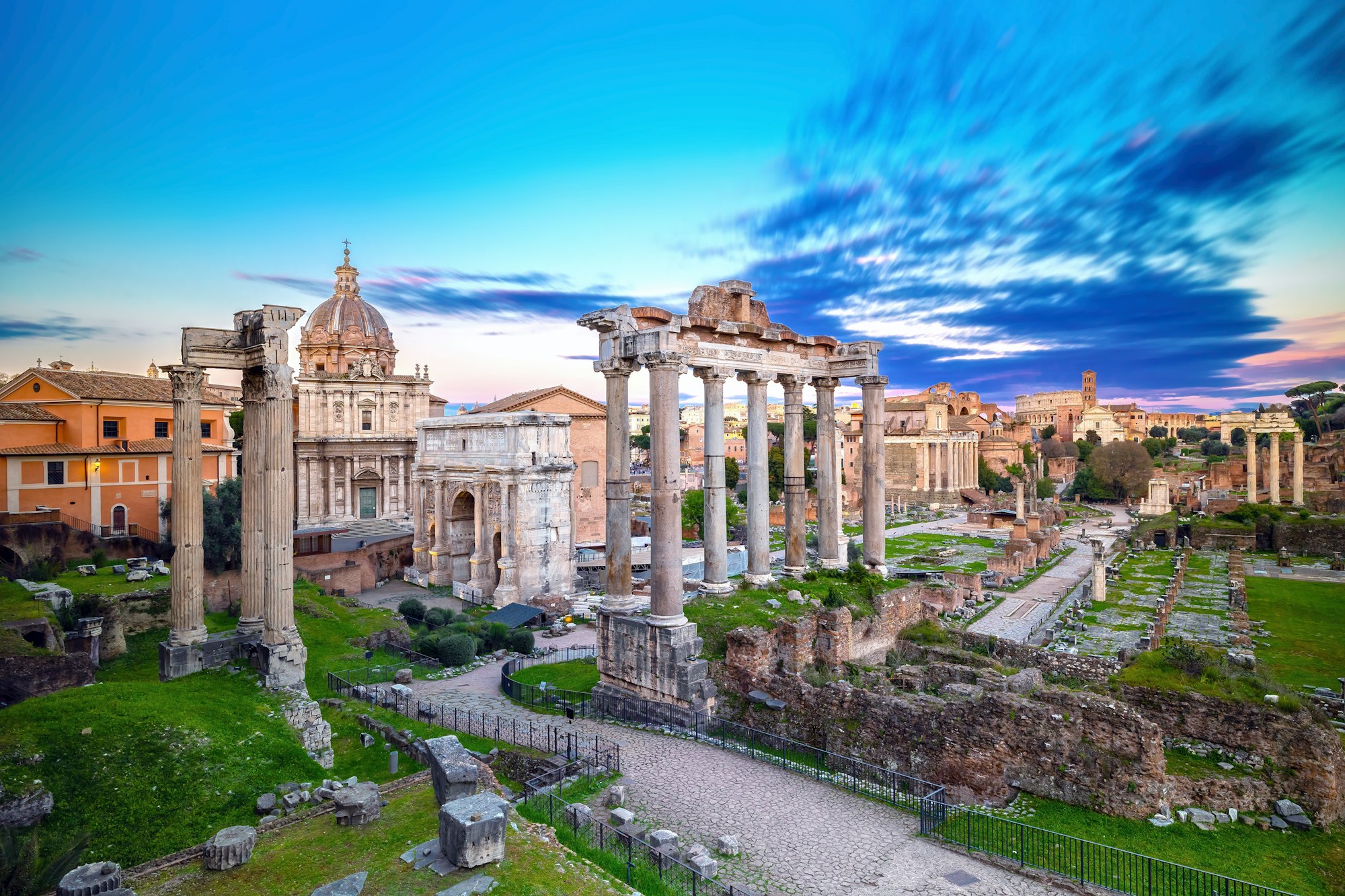
Colosseum Park with the Imperial Forums
Although the ruins may look like a complex labyrinth today, each structure had a precise function: the Temple of Saturn guarded the public treasury, while the Basilica of Maxentius offered a space for judicial and commercial activities. The Curiathe seat of the Roman Senate, was the hub of political life, where decisions were made that influenced the empire and its citizens.
Today, the Roman Forum is an archaeological site of inestimable value, offering visitors the opportunity to immerse themselves in the life in ancient Rome. Despite the passage of centuries and changes in the urban landscape, this place continues to tell stories of power, devotion and daily life that are at the heart of Roman history. A visit to the Forum is not just an excursion to an ancient site, but a journey through time that provides insight into the social, political and religious dynamics that defined one of the most influential civilisations in history.
La Trevi Fountain is not just a fountain; it is a baroque masterpiece which encapsulates the essence of Italy's artistic creativity and imagination. Located in the heart of Rome, this extraordinary fountain is much more than a work of art; it is a symbol of hope and tradition that attracts visitors from all corners of the globe. Designed by Nicola Salvi and completed in 1762, the Trevi Fountain is the largest and is considered the most beautiful fountain in the city, a true jewel of Baroque architecture that leaves one speechless with its magnificence and detail.
In the centre of the scene, the statue of the god Neptune emerges from a shell, pulled by sea horses led by tritons. Water roars around them, creating an illusion of movement and sound that brings the stone to life. The fountain represents the theme of water as a source of life and well-being, a reminder of the original function of Roman fountains to provide drinking water for the population.
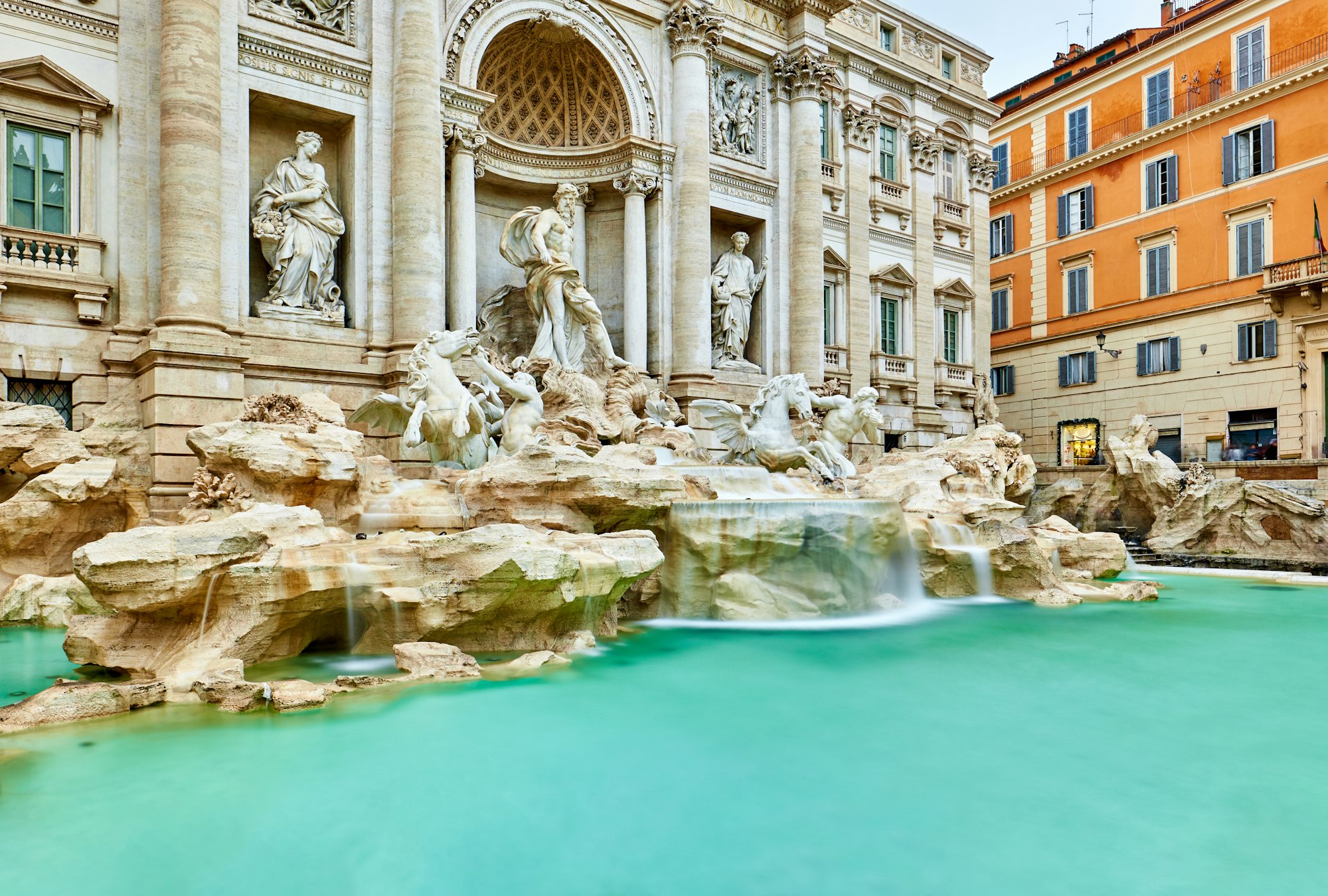
Trevi Fountain in Rome
One of the most beloved traditions associated with the Trevi Fountain is that of tossing a coin with the right hand over the left shoulder, which according to legend ensures a return to Rome. This symbolic gesture, immortalised in numerous films and stories, has helped make the Trevi Fountain a place where dreams and hopes take shape, a meeting point between past, present and future.
Every year, millions of people visit the Trevi Fountain, making it one of the most photographed sites in Rome. Its majestic beauty at sunset, when the lights illuminate the water and sculptures, creates a magical atmosphere that seems suspended in time. The Trevi Fountain is not just a tourist attraction; it is an experience that remains in the heart and soul, an indelible reminder of Rome's grandeur and charm.
Spanish Steps and the Spanish Steps represent one of the most iconic places in Rome, an image that evokes the elegance, history and art of the eternal city. This architectural complex, located in the heart of historic centreIt is a meeting point of different cultures, languages and traditions, testifying to Rome's ability to be both a global city and deeply rooted in its historical identity.
The staircase, consisting of 135 steps, was built between 1723 and 1725 to connect the Piazza with the Trinità dei Monti church. This architectural marvel is adorned every spring with colourful flowers that add a touch of liveliness and freshness, turning the Scalinata into a veritable urban garden. The square below, with its characteristic shape and the Fountain of the Barcaccia by Pietro Bernini, is an open-air theatre where Roman life is expressed in all its nuances.
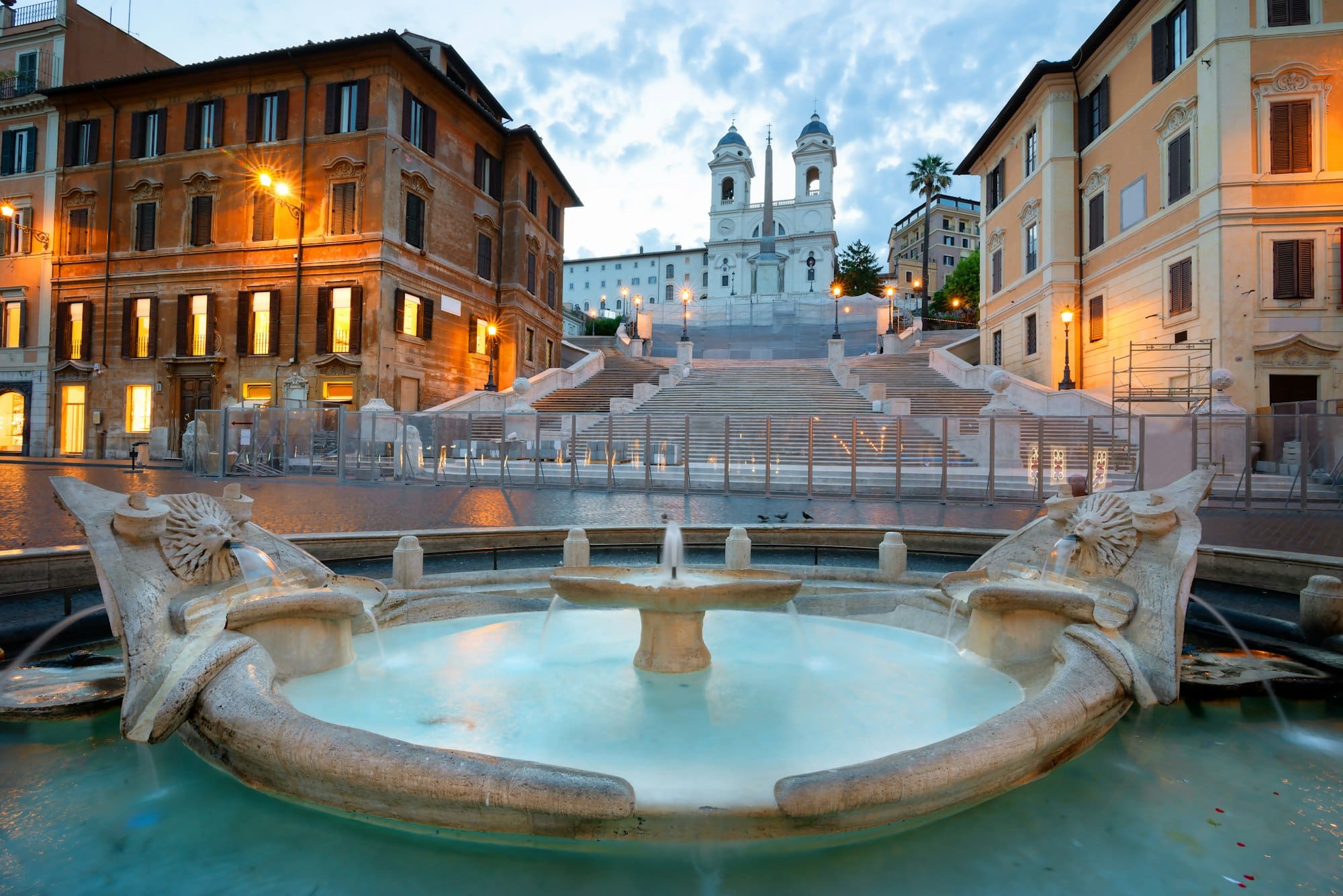
Piazza di Spagna in Rome
For centuries, Piazza di Spagna has been a meeting place for artists, poets and writers from all over the world, attracted by the beauty of the city and the unique atmosphere in this corner of Rome. Even today, the square and the steps are a crossroads of cultures, a place where history is intertwined with everyday life, and where every stone, every step, tells a story.
From the top of the Steps, the view sweeps over the city, offering one of the most striking views of Rome. At sunset, when soft lights illuminate the square and the facades of the surrounding buildings, the atmosphere becomes magical, almost suspended. This place is not just a tourist attraction, but the beating heart of Roman elegance and history, a symbol of the art of living that has characterised the Italian capital for centuries.
Visit Piazza di Spagna and the Spanish Steps to immerse yourself in the very essence of Rome, a city that continues to enchant and inspire with its timeless beauty.
The Pantheon represents one of the architectural wonders of antiquity, a temple dedicated to all the Roman gods that has defied time, remaining remarkably preserved through the centuries. Originally built during the reign of Agrippa in 27 BC and later rebuilt by Hadrian around 126 AD, this structure is a living testament to the greatness of the Roman Empire and its advanced engineering.
The most remarkable feature of the Pantheon is undoubtedly its imposing dome, the largest unreinforced concrete dome in the world to this day. In the centre of the dome is the oculus, a circular opening that serves as the only source of natural light for the entire building, creating a symbolic connection between the temple and the heavens. The oculus and the dome together symbolise heaven and earth, reflecting the cosmological vision of the Romans and their devotion to the gods.
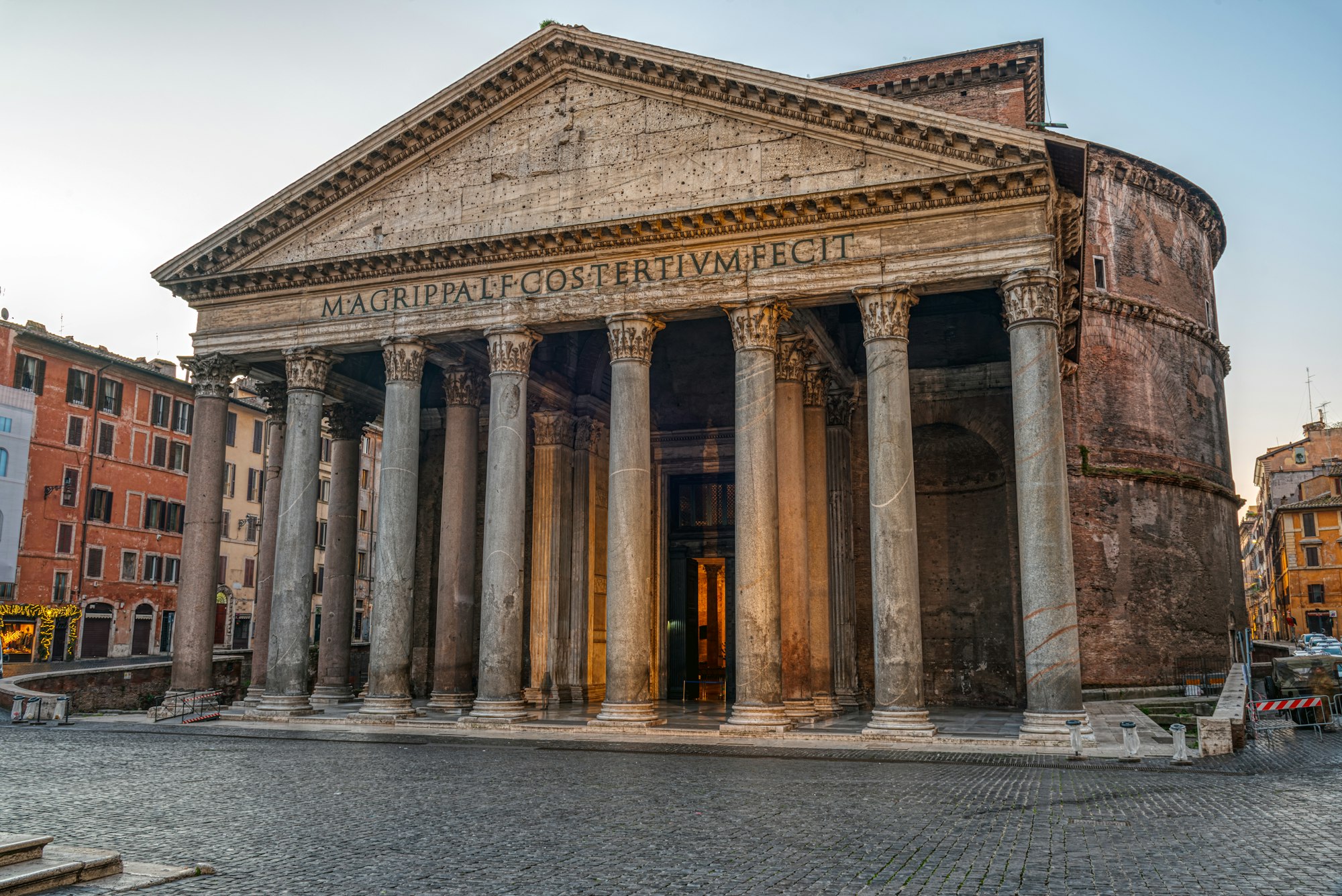
The Pantheon in Rome
Entering the Pantheon is like stepping back in time. One is immediately struck by the majesty and theharmony of proportions, a perfect example of classical beauty that has influenced western architecture for millennia. The temple was transformed into a Christian church in 609 A.D., dedicated to St. Mary ad Martyres, but has continued to preserve its essence and grandeur.
The Pantheon is not only a historical monument; it is a place of reflection and of inspirationa bridge between past, present and future that demonstrates how human ingenuity can create works of such magnificence that they become almost eternal. A visit to this temple is an almost mystical experience, allowing one to perceive the deep connection between man, art and divinity.
La Vatican City may be the smallest independent state in the world, but its cultural and spiritual influence extends far beyond its borders. Located in the heart of Rome, this sovereign enclave is a place of deep faith and extraordinary beauty, home of the St Peter's Basilica and the Vatican Museumscustodians of some of humanity's most precious and significant works of art.
St. Peter's Basilica is a Renaissance masterpiece, whose majestic dome, designed by Michelangelo, dominates the skyline of Vatican City. Inside, the basilica is revealed in all its glorious beauty, with works of art ranging from the Michelangelo's Pieta to Bernini's imposing altar. St. Peter's Square, with its iconic double row of columns, welcomes pilgrims and visitors from all over the world, a symbol of unity and welcome.
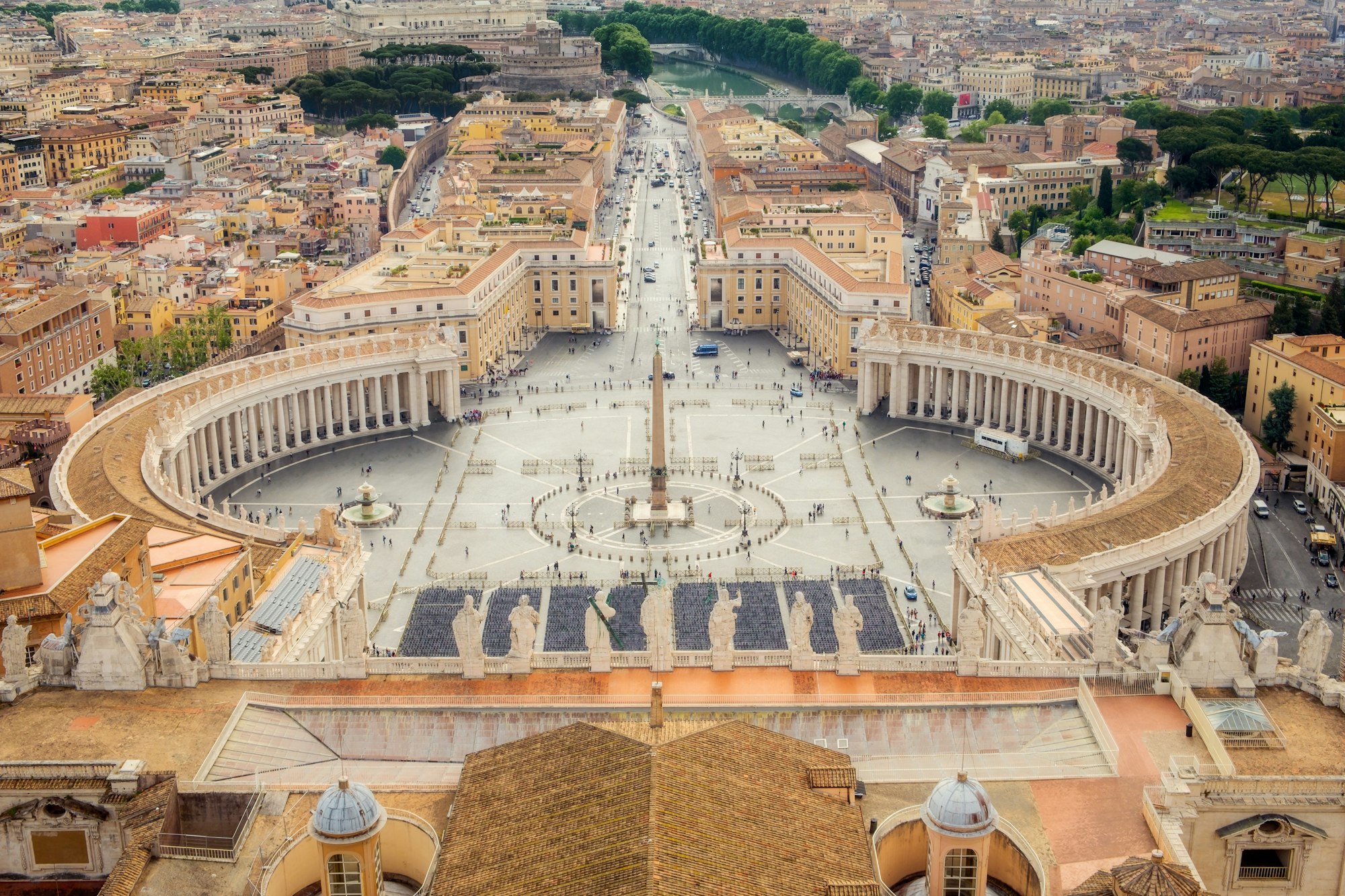
Vatican City
The Vatican Museums offer a journey through the history of art and faith, housing a vast collection ranging from Egyptian and Roman antiquity to the Renaissance and beyond. The highlight of this extraordinary experience is the Sistine Chapelwith its famous ceiling and Michelangelo's Last Judgement, masterpieces that changed the course of Western art.
A visit to Vatican City is not complete without a reflection on its importance as a centre of Catholic spirituality. St Peter's Square and the Basilica are not only historical monuments or works of art; they are places of meeting, of prayer and of spiritual reflectionwhere the depth and continuity of faith through the centuries can be perceived.
Exploring Vatican City means immersing oneself in a world where art, history and spirituality are inextricably intertwined, offering visitors a unique and deeply moving experience. Whether admiring the magnificence of St. Peter's Basilica, losing oneself in the halls of the Vatican Museums or reflecting in the stillness of the Sistine Chapel, Vatican City remains a place of immense cultural and spiritual value, a priceless treasure in the centre of the Eternal City.
Castel Sant'Angelo began its history as a mausoleum, conceived by Emperor Hadrian in 123 A.D. for himself and his successors, transforming over the centuries into a fortress, papal residence, and finally into a museum. This transformation bears witness to the multiple lives of a building that has watched Rome evolve from the height of its imperial power to the present day. Situated on the right bank of the Tiber, close to the Vatican, the castle is connected to the city by the impressive Sant'Angelo Bridgeadorned with statues of angels sculpted to a design by Bernini.
Its imposing structure served as a refuge and fortress for the Popes during times of danger, underlining its strategic importance and its role in the defence of the city. The transformation from mausoleum to fortress is evident in its thick walls and secret passages leading to Vatican City, evidence of a turbulent past when security was a priority.
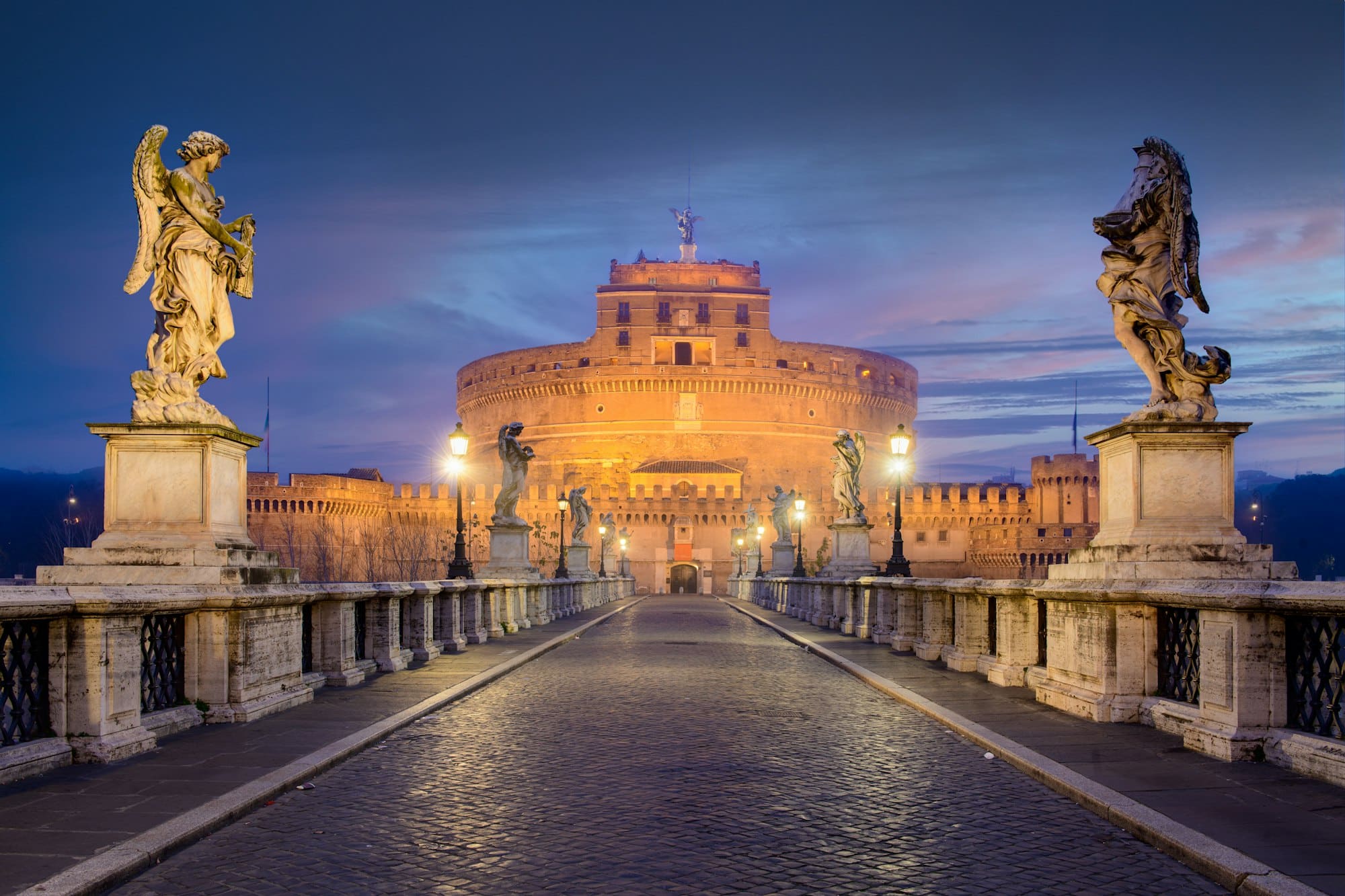
Castel Sant'Angelo in Rome
Today, Castel Sant'Angelo offers one of the more breathtaking views over Rome. From its upper terrace, visitors can enjoy a 360-degree view encompassing the dome of St. Peter's, the Tiber River, and the endless rooftops and domes that characterise the Roman landscape. This unique perspective makes the castle a privileged vantage point, where the historical grandeur and natural beauty of the city merge into a single, unforgettable panorama.
A visit to Castel Sant'Angelo is a journey through the history of Rome, from its ancient roots to the Renaissance and beyond. Its rooms, once a papal residence, now house art collections that tell the rich history of the building and the surrounding city. Castel Sant'Angelo is not just a monument or a museum; it is a symbol of Rome's historical continuity, a bridge between past and present that continues to enchant and inspire those who visit it.
Piazza Navona is one of the most lively and picturesque places in Rome, a true open-air stage where art, history and everyday life meet. Characterised by its elongated shape that follows the contours of an ancient Roman stadium, the square is a perfect example of the Baroque style that dominates the city's architecture and art.
Le sculptural fountains by Gian Lorenzo Bernini, in particular the famous Fountain of the Four Riversare the artistic centrepiece of the square. This fountain, with its imposing statues representing the rivers Nile, Ganges, Danube and Rio de la Plata, symbolises the artistry of the Baroque and the cosmopolitan vision of 17th century Rome. The other two fountains, the Fountain of the Moor and the Fountain of Neptune, add to the charm of the square, creating a magical and timeless atmosphere.
La lively atmosphere Piazza Navona is fuelled not only by its architectural wonders, but also by the presence of cafés, street artists and painters who fill the square with life and colour. This unique mix of historical beauty and contemporary creativity makes Piazza Navona a favourite meeting place for Romans and visitors from all over the world.
The square is surrounded by historical buildings, including the Palazzo Pamphilj, which houses the Brazilian embassy, and the Church of Sant'Agnese in Agone, designed by Francesco Borromini, Bernini's rival. This artistic competition between two of the greatest Baroque masters has left Rome with one of its most spectacular settings.
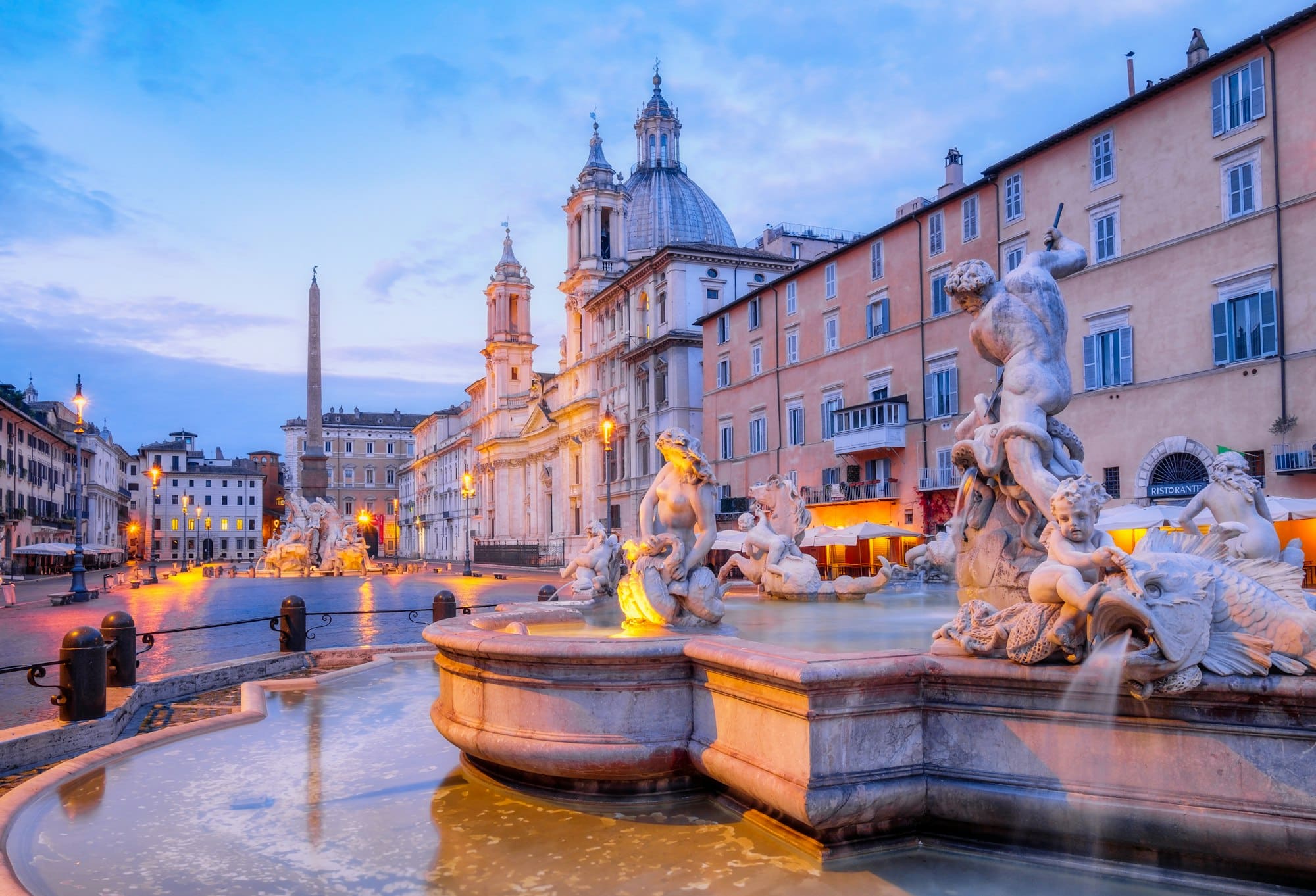
Pizza Navona with the Fountain of the Four Rivers
To visit it is to immerse oneself in the history and in Roman culturesavouring the essence of life in the Eternal City. The combination of extraordinary art, impressive architecture and cultural dynamism makes Piazza Navona one of the most fascinating and unmissable places in Rome, a landmark that continues to inspire and enchant anyone lucky enough to stroll through it.
La Borghese Gallery is not simply a museum: it is one of the most fascinating art collections in the world, housed in the enchanting setting of Villa Borgheseone of the largest and most beautiful parks in Rome. Founded by Cardinal Scipione Borghese in the early 17th century, the gallery houses an incredible collection of works ranging from the Renaissance to the Baroque, with masterpieces by some of the greatest artists in history such as Caravaggio, Bernini e Raphael.
Cardinal Borghese, a passionate collector and patron of the arts, assembled an exceptional assortment of sculptures, paintings and antiquities. Prominent among these are the vibrant canvases by Caravaggio, such as 'David with the Head of Goliath' and 'Sick Bacchus', which fascinate with their emotional intensity and innovative use of light and shadow. No less extraordinary are the sculptures by Bernini, whose works such as 'Apollo and Daphne' and 'The Rape of Proserpine' demonstrate an incredible ability to capture movement and human emotion in marble.
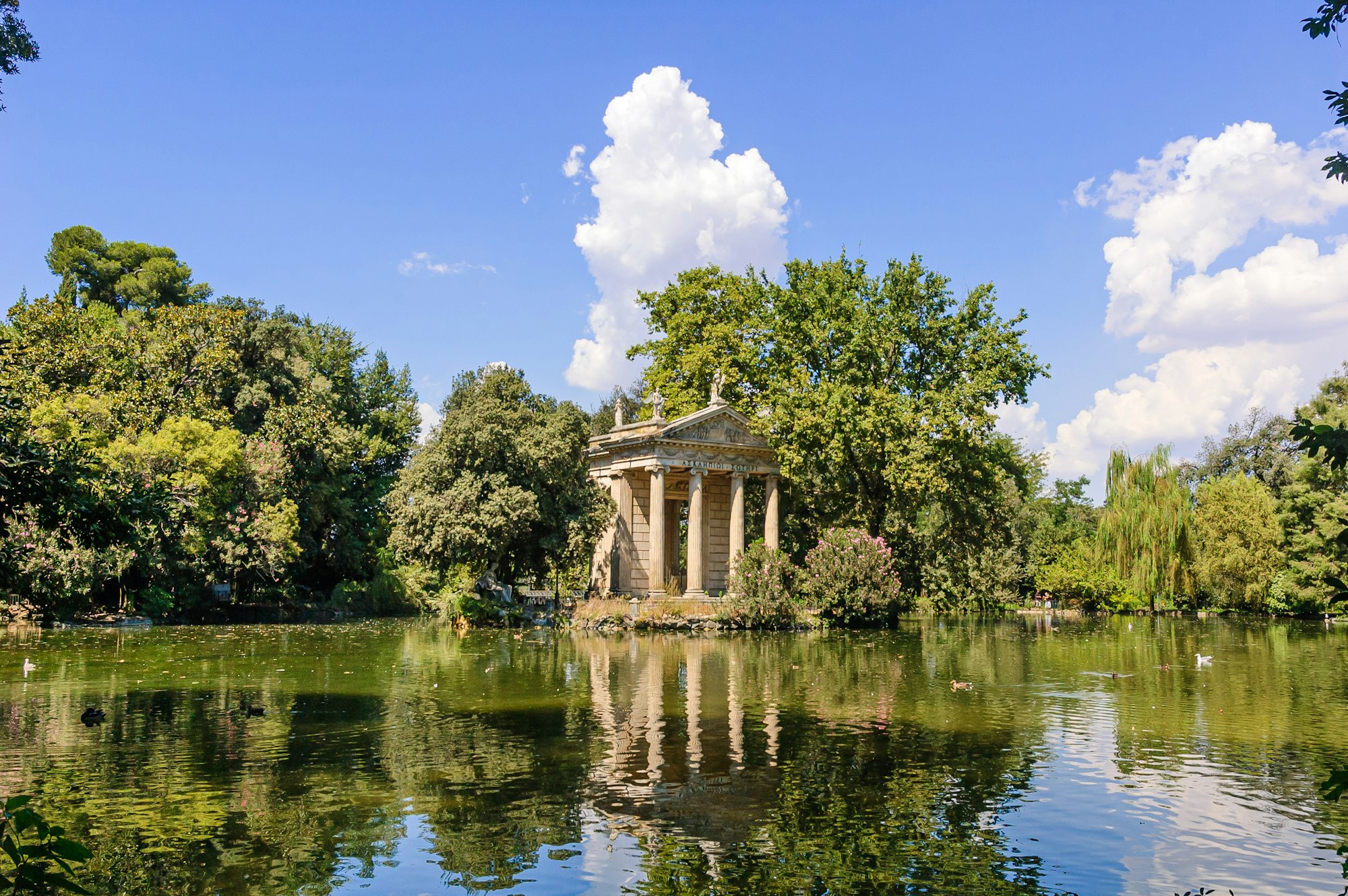
Villa Borghese in Rome
Raphael is another pillar of the collection, with works such as the 'Borghese Deposition' representing the pinnacle of his mastery of drawing and composition. The Galleria Borghese, however, is not just a place to admire the works of the great masters; it is an experience that allows one to completely immerse oneself in art, thanks also to the elegant interior layout that reflects the style and taste of the Baroque era.
A visit to the Borghese Gallery offers a journey through time, where the beauty of art merges with the history of the Borghese family and Baroque Rome. Each room, each corridor, tells a story of passion for art, political intrigue and collecting, making the gallery a living, breathing place, a real hidden treasure within the lush greenery of Villa Borghese.
Trastevere is the district that best embodies the bohemian essence of Rome, with its narrow cobbled streets winding between old ochre houses, sudden panoramic views and hidden squares where time seems to stand still. By day, Trastevere glows with the warm sunlight that accentuates the vibrant colours of its façades, while at night it is transformed, lighting up with life thanks to the many restaurants, cafés and clubs that offer a unique culinary and cultural experience.
Strolling through Trastevere is like diving into another era, where every corner tells a story, every square hides a legend. The district has kept its authentic character intact, despite its growing popularity among tourists. Here, the atmosphere is made even more special by the friendliness of its inhabitants, who welcome visitors from all over the world with the warmth typical of the Roman tradition.
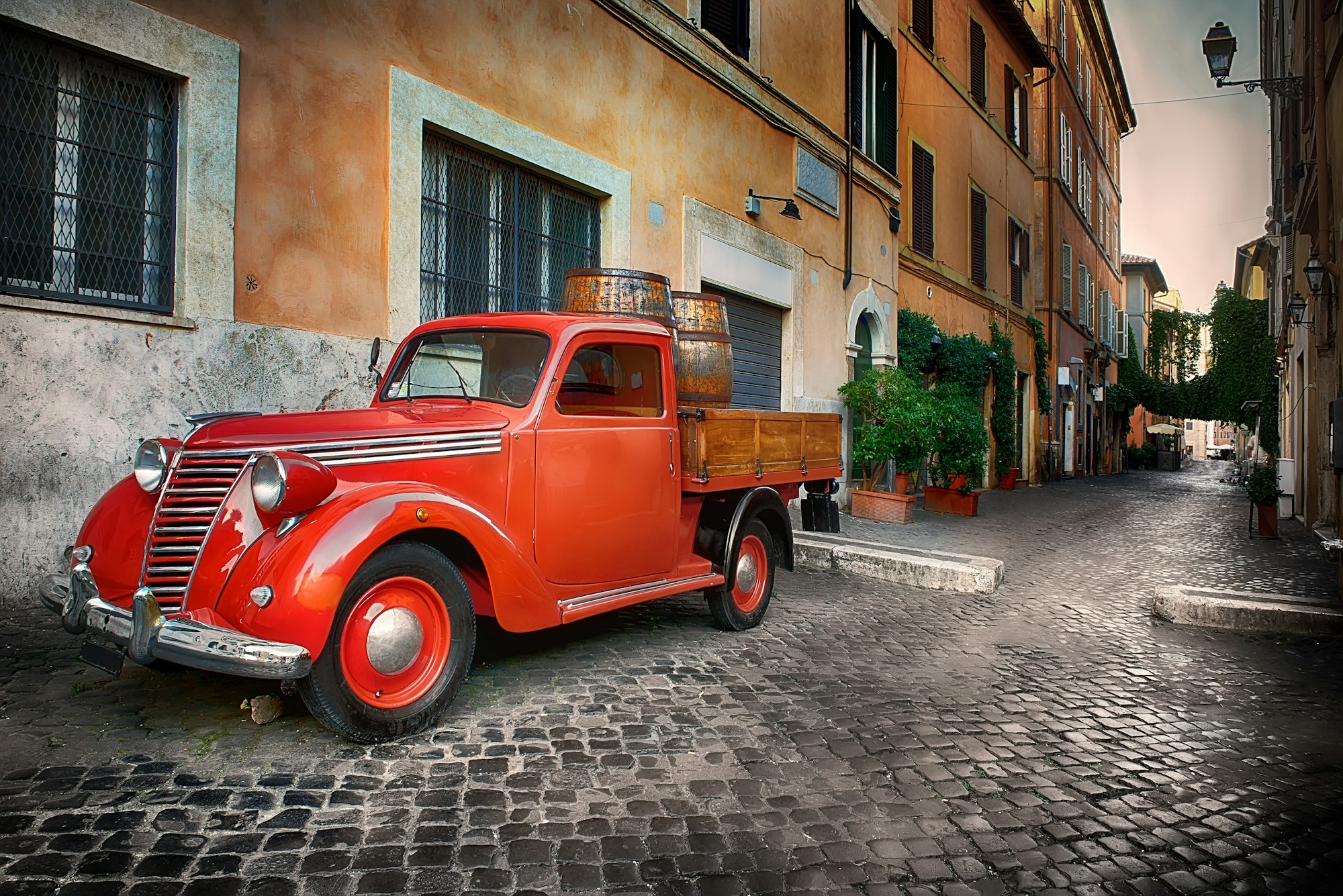
Trastevere in Rome
The beating heart of Trastevere is Piazza di Santa Maria in Trasteveredominated by the basilica of the same name, one of the first places of Christian worship in Rome, famous for its golden mosaics that shimmer under the blue sky or the stars at night. But Trastevere is also the district of nightlifesmall restaurants where you can taste the real Roman cuisineworkshops that keep local traditions alive.
Living Trastevere means immersing yourself in a unique atmosphere, where art, history and daily life intertwine in a mosaic of unforgettable experiences. It is the ideal place for those seeking the most authentic soul of Rome, far from the beaten track, where it is possible to discover the charm of a city that never ceases to surprise.
In this neighbourhood, every evening stroll turns into an adventure, every dinner into an experience to remember. Trastevere represents the essence of a lesser-known but no less fascinating Rome, an invitation to explore, to get lost in its alleys, to be captured by its free spirit and untamed beauty.
I Markets of Trajan represent one of the most advanced architectural achievements of ancient Rome, considered by many historians as the first example of a 'commercial centre' in the world. Built between 100 and 110 A.D. during the reign of Emperor Trajan, these markets were a complex of multifunctional buildings located on the slopes of the Quirinal Hill, designed to house administrative offices and commercial spaces.
The structure, innovative for its time, comprised several levels with over 150 shops and workshops, offering a wide range of goods, from foodstuffs to textiles, from spices to luxury goods from all over the empire. The layout of the spaces, the wide corridors and the large sales rooms anticipate the characteristics of modern shopping centres, demonstrating the incredible ingenuity of the Roman architects.
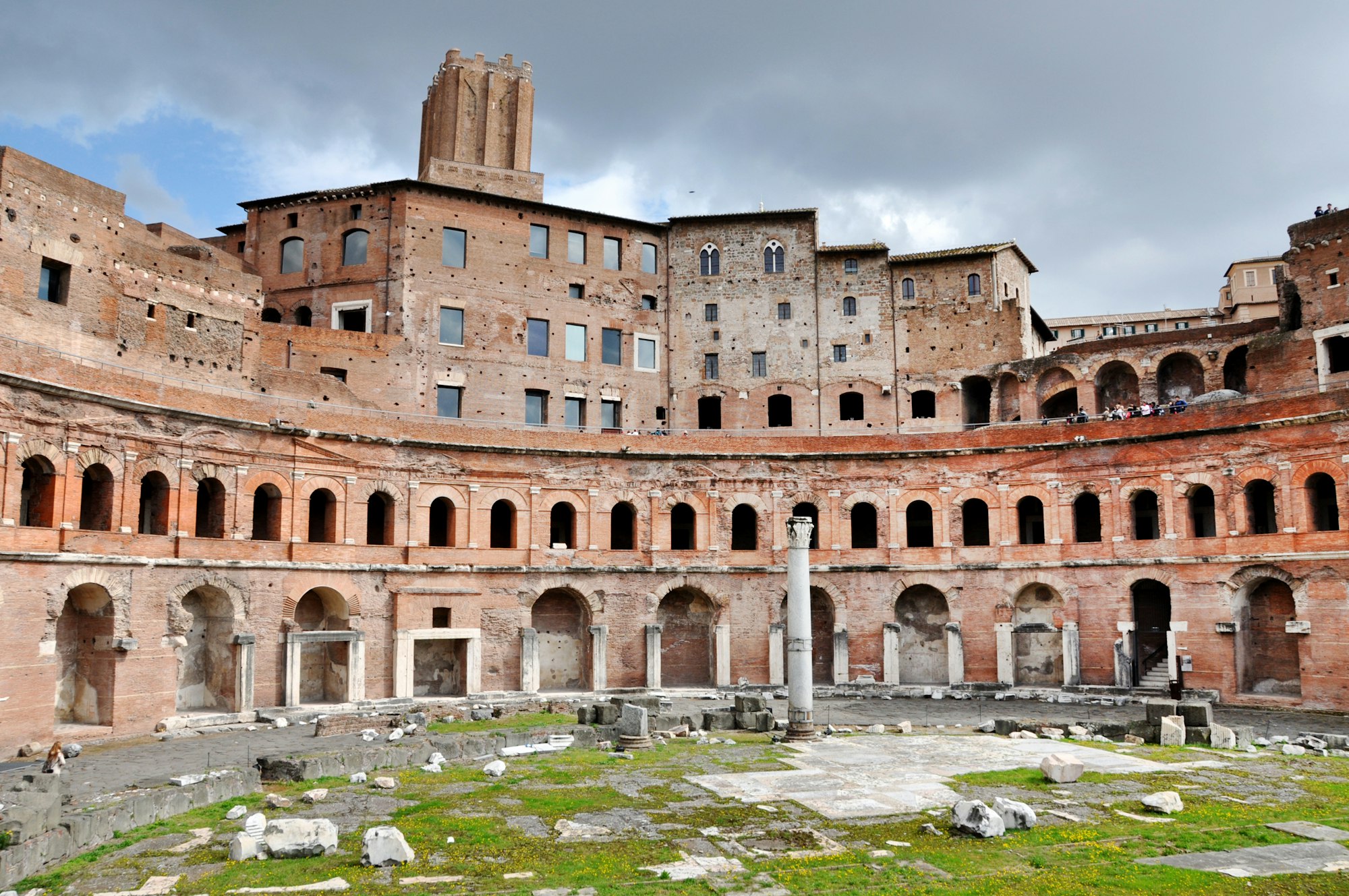
Markets of Trajan
The complex was also equipped with an advanced drainage system to prevent flooding, and its large concrete vaults are an early example of the Romans' innovative use of concrete. These features not only highlight the advanced understanding of Roman building techniques but also their ability to create functional spaces for the well-being of society.
Today, the Markets of Trajan offer visitors a unique insight into ancient daily lifeallowing one to imagine the bustle and commercial activity that animated this place almost two thousand years ago. The complex is not only a monument to the greatness of Rome, but also a tangible testimony to the daily routines and economic practices of the ancient Romans.
A visit to Trajan's Markets is an unmissable opportunity for anyone interested in discovering lesser-known aspects of Roman daily life, offering the chance to walk through the same spaces that were frequented centuries ago by traders, craftsmen and citizens of the Empire. This archaeological site is not only a journey into the past, but also a reflection on how certain urban functions have remained unchanged over the millennia, linking ancient Rome to the contemporary world.
The Circus Maximus is one of Rome's most emblematic sites, witness to almost three thousand years of history. Originally conceived as an arena for chariot races, this vast open space located between the Palatine and the Aventine was, in antiquity, the scene of some of the most spectacular and exciting spectacles of the time, capable of attracting up to 250,000 spectators. The chariot races, together with the circus games, were social events of great importance, providing entertainment and, at the same time, strengthening the bond between the emperor, the ruling classes and the people.
The Circus Maximus has experienced moments of glory and periods of neglect, reflecting the ups and downs of the city of Rome. After the fall of the Roman Empire, the arena was gradually forgotten and turned into farmland, losing its original function. However, its outline has remained imprinted in the urban landscape, allowing its shape and size to be easily identified even today.
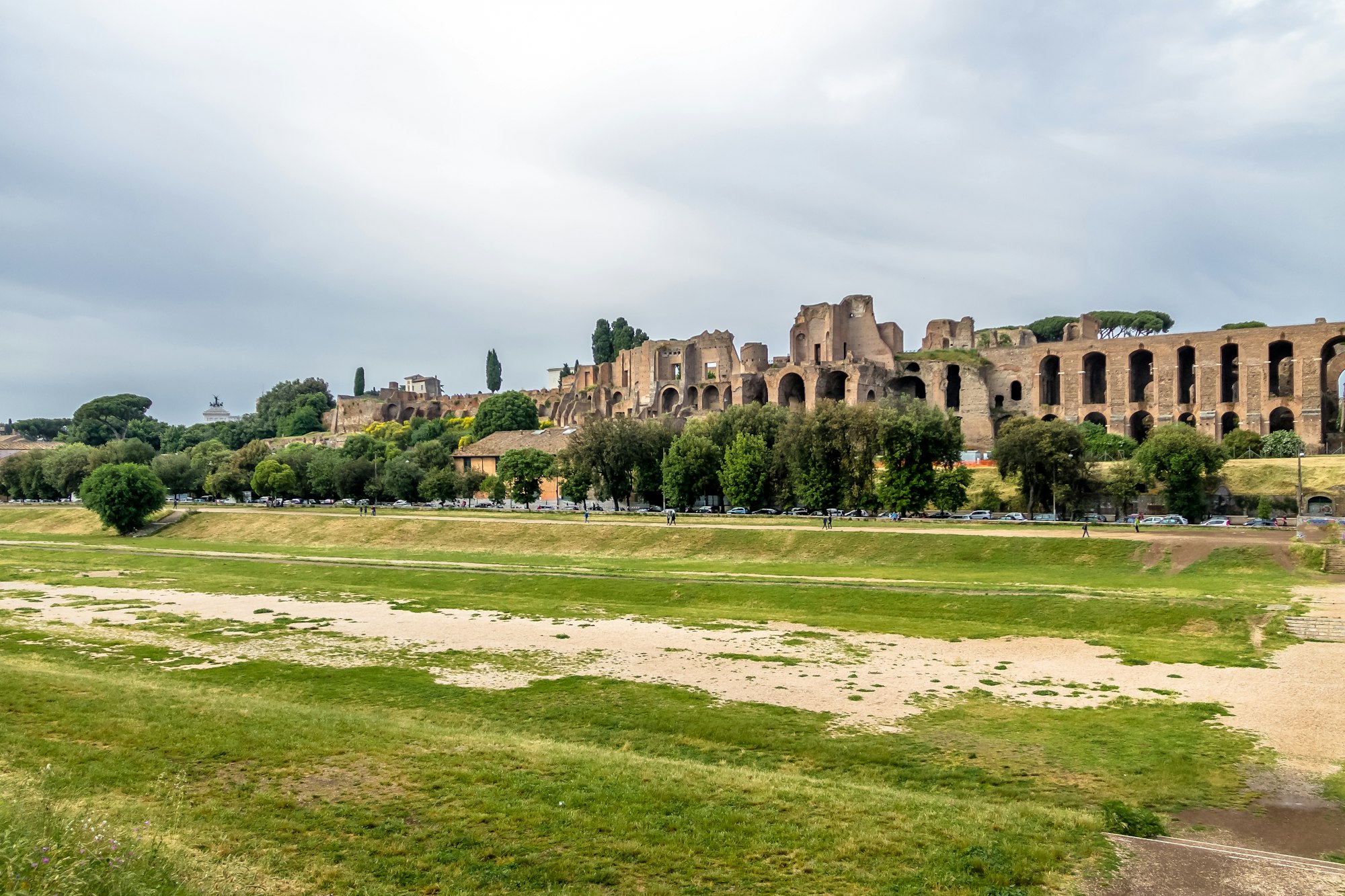
Circus Maximus in Rome
In the modern era, the Circus Maximus has experienced a renaissance, becoming one of the largest open spaces for events and concerts in Italy. This historic venue has hosted some of the biggest names in international music and world-class public events, becoming a symbol of Rome's ability to renew and adapt, without ever losing touch with its rich past.
The transformation of the Circus Maximus from ancient arena to modern stage is an extraordinary example of how urban spaces can be reinterpreted and enhanced over time. Today, walking around its perimeter or attending one of the events held there, one can perceive the echoes of the chariot races that once inflamed the spirits of spectators, but also appreciate the liveliness and energy of contemporary Rome.
The Circus Maximus is not just a green area or a place of entertainment; it is a bridge between past and present, a silent witness to Rome's thousand-year history and its continuous evolution. To visit it is to immerse oneself in a unique atmosphere, where the memory of the ancient city and the spirit of modern Rome meet and dialogue, offering a timeless experience.
Le Baths of Caracalla are among the most majestic and impressive ruins that ancient Rome has left us, a monument testifying not only to Roman architectural ingenuity but also to their conception of luxury and social well-being. Built between 212 and 216 A.D. at the behest of Emperor Caracalla, these baths were much more than just public baths: they were a multifunctional centre for relaxation, sport and culture, capable of accommodating thousands of people every day.
Spread over some 11 hectares, the baths included not only pools of various temperatures, but also gymnasia, libraries, massage rooms and even a theatre. Visitors could immerse themselves in the warm waters of the calidarium, cool off in the frigidarium and socialise in the spacious natatio, outdoor pools surrounded by colonnades and statues. This structure, rich in artistic decorations, mosaics and sculptures, reflected the grandeur of the Roman Empire and its ability to integrate art into everyday life.
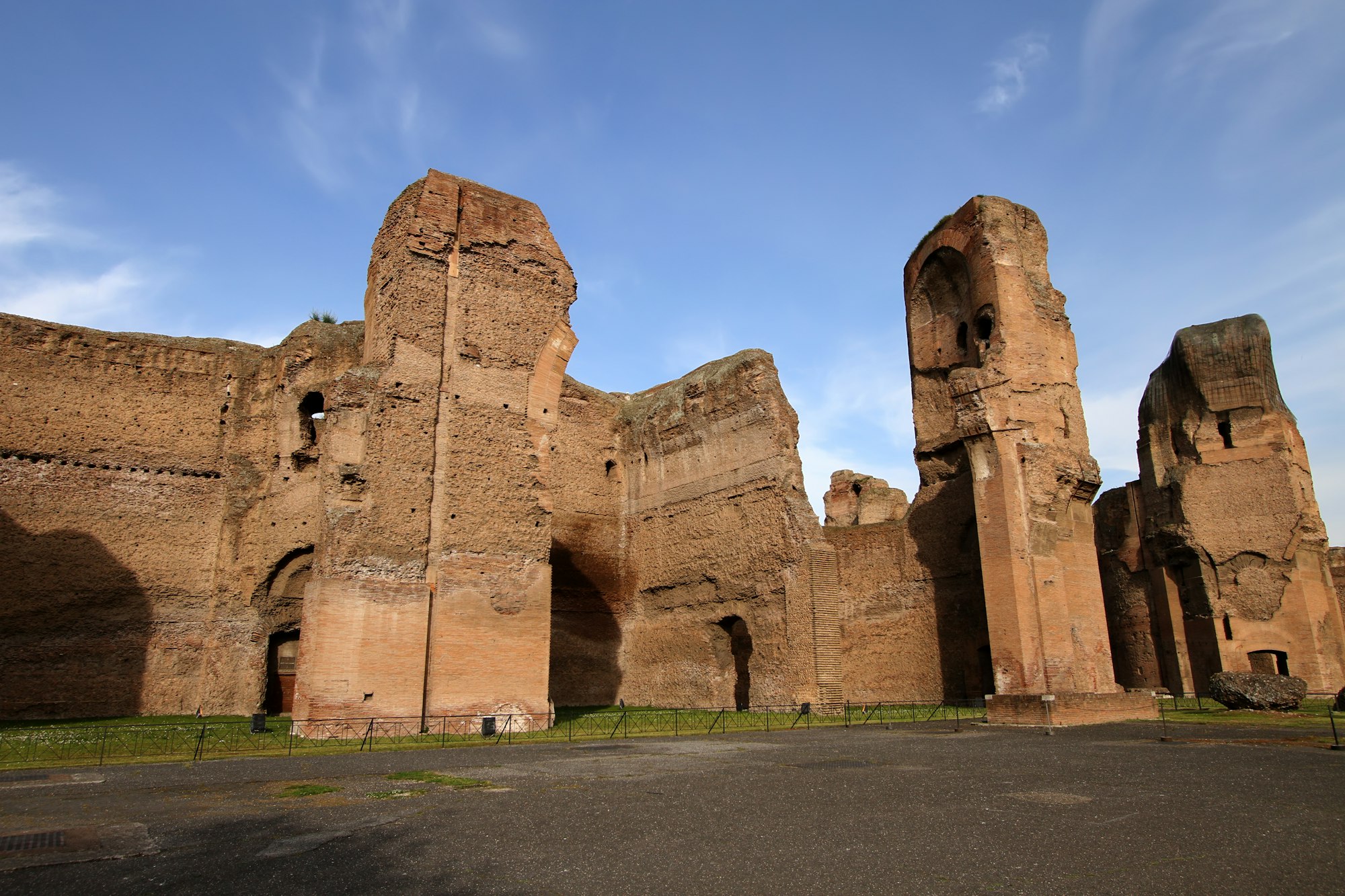
Baths of Caracalla
Le Baths of Caracalla were not only a place of recreation, but also a symbol of imperial power and its benevolence towards its citizens, offering free access to luxury services. Water for the baths was brought through a sophisticated system of aqueducts, and advanced underfloor heating systems ensured a constant temperature, demonstrating advanced Roman engineering technology.
Today, visiting the ruins of the Baths of Caracalla offers a unique insight into Roman luxury life and their advanced concept of public welfare. Walking within these ancient walls, one can imagine the daily life of the ancient Romans, amidst luxurious baths, physical exercises and philosophical discussions, in an environment that was both an architectural marvel and a vital centre of the community.
La Via Appia Anticaknown as the Regina Viarum, is one of the most famous and historic roads of the ancient world. Inaugurated in 312 BC by Appius Claudius Blind, this road was one of the main arteries of the Roman Empire, connecting Rome to southern Italy. In addition to its strategic and commercial importance, the Via Appia became famous for its scenic beauty and the many monumental tombs and Christian catacombs that line its route.
The road today offers a unique experience, a journey back in time among ancient ruins, buried catacombs and natural landscapes that have changed little over the centuries. Walking along the Via Appia Antica means walking the same pavement on which armies, merchants, pilgrims and historical figures marched, immersed in an atmosphere that vividly evokes the grandeur and complexity of Roman history.
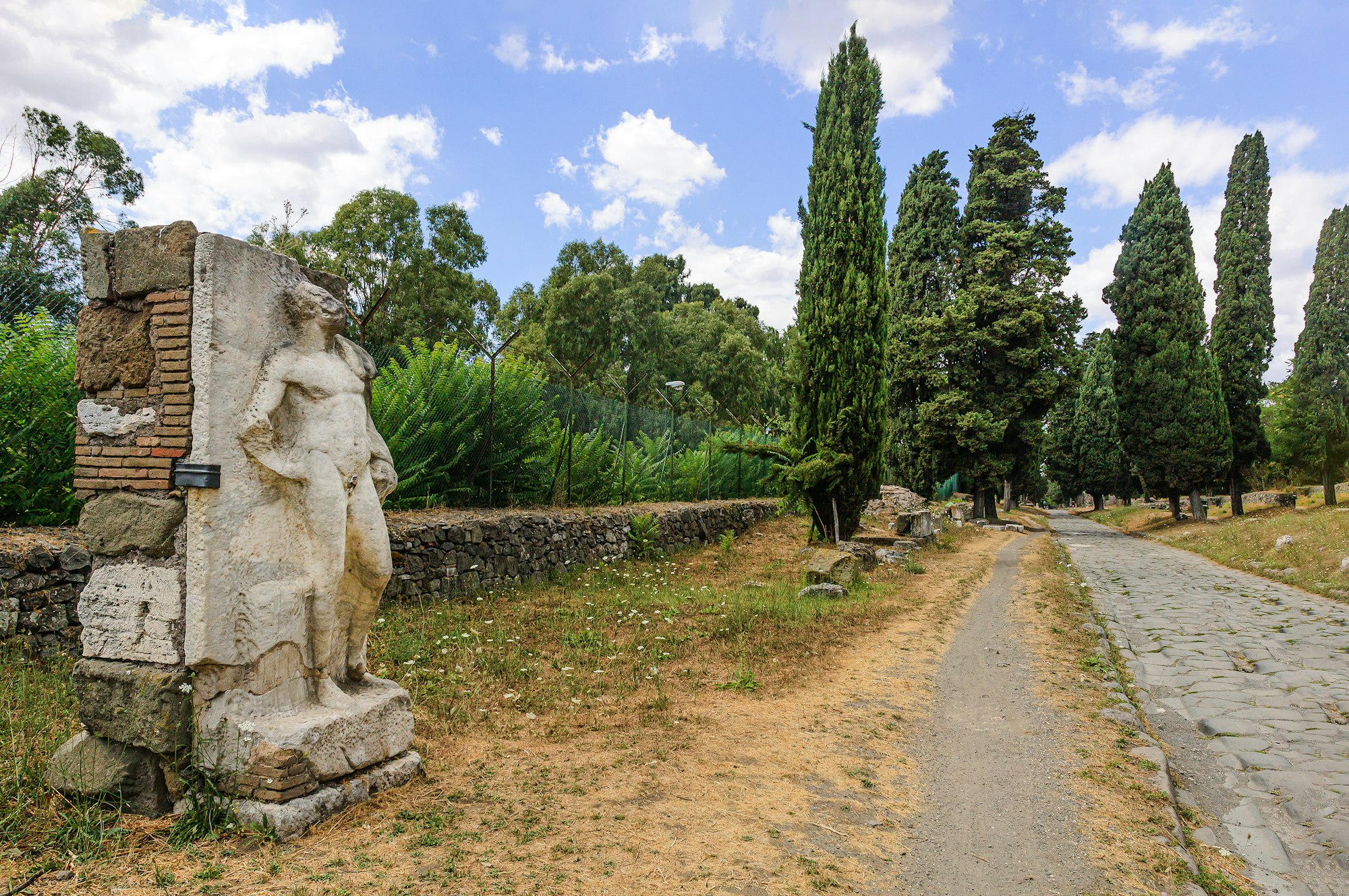
Via Appia Antica
The catacombs, such as those of St Callistus and St Sebastian, offer a fascinating insight into early Christian burial practices and the life of the Christian community in ancient Rome. These underground sites, rich in frescoes, inscriptions and early Christian symbols, are silent witnesses of faith and hope in times of persecution.
The Via Appia Antica today is also a place of natural refuge and of recreation for citizens and visitors to Rome. The park surrounding the historic street is a protected area, perfect for walking, cycling or outdoor picnics, offering a relaxing break from the hustle and bustle of the modern city.
The preservation of this historic site is essential not only for its archaeological value but also as an urban green space that contributes to the well-being of the community. Visiting the Via Appia Antica is an experience that physically and spiritually connects visitors with the deep roots of Roman history and culture, in an environment where the nature and history are inextricably intertwined.
Ostia Anticaonce a bustling port of ancient Rome, today stands as one of the most significant and best-preserved archaeological sites, offering an authentic and detailed insight into daily life in antiquity. Located only 30 kilometres from the capital, this ancient port city serves as a silent witness to the time when it was a nerve centre for the trade and distribution of grains and goods essential for the sustenance of Rome's population.
Founded in the 4th century B.C., Ostia played a crucial role in the Roman economy, serving as a gateway to the Mediterranean and as the starting point for trade routes connecting the Empire. Over the centuries, the city grew in importance and size, expanding into a prosperous community with an amphitheatre, baths, temples, and a multitude of houses and shops reflecting the richness and diversity of Roman urban life.
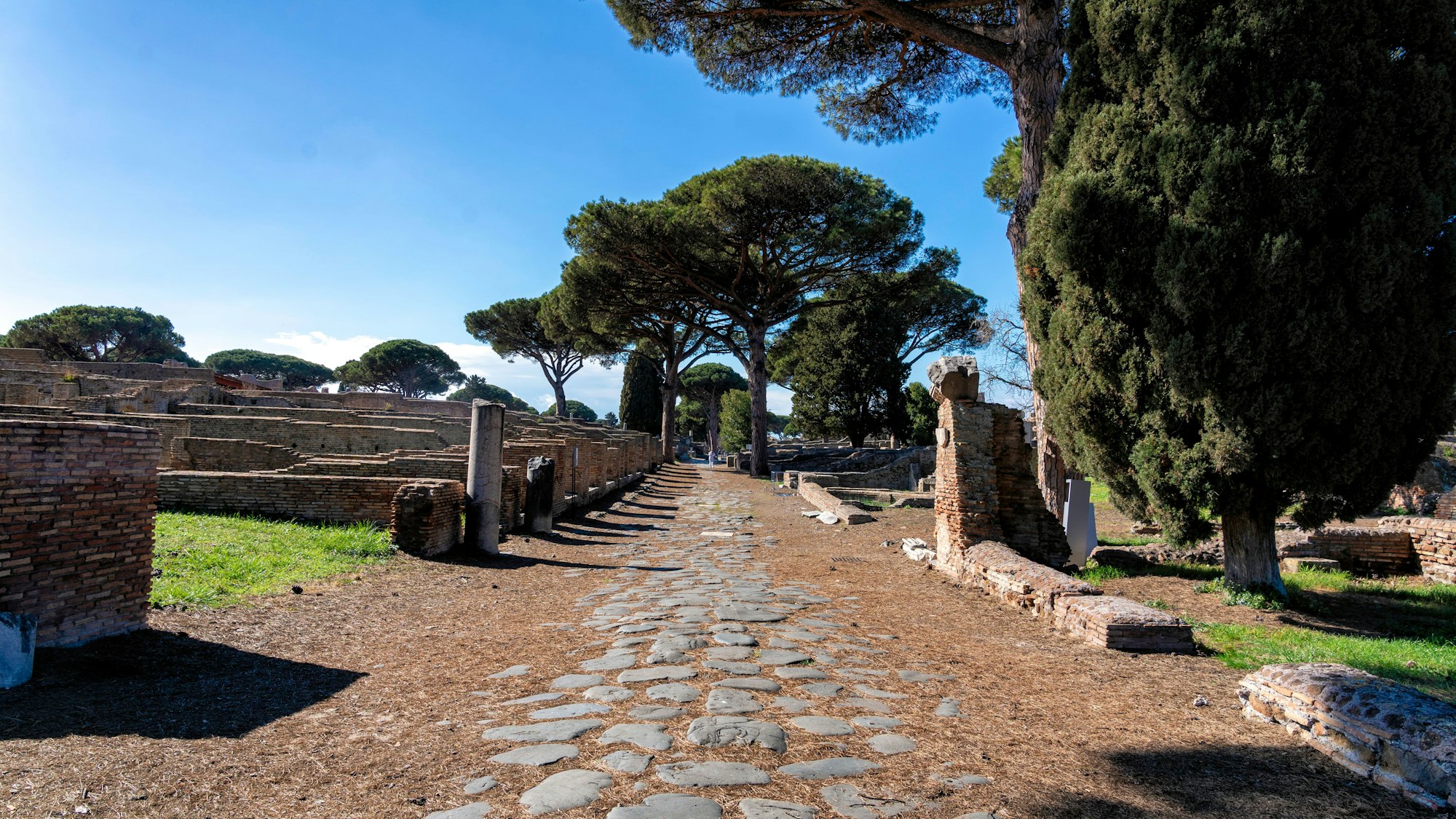
Ostia Antica Rome
A visit to Ostia Antica allows visitors to stroll along the ancient cobbled streets, enter the houses and public buildings, admire the well-preserved mosaics and frescoes decorating the interiors, bearing witness to the art and culture of a bygone era. The Forum, the beating heart of the city, the Amphitheatre, which can still accommodate spectators today, and the Baths of Neptune, with their impressive mosaics, are just some of the highlights that make this site a place of extraordinary historical and cultural interest.
Ostia Antica therefore offers not only a glimpse into the grandeur of the Roman Empire, but also an immersion into the ordinary, into the daily routine of those who lived centuries ago, allowing visitors to connect with the past in a direct and meaningful way. This archaeological site provides a unique opportunity to understand the dynamics of ancient life, shedding light on the social, economic and cultural aspects that defined Roman society.
The Coppedè neighbourhood is one of Rome's best-kept secrets, a hidden architectural gem that escapes the traditional tourist routes. This small neighbourhood, located between Parioli and Nomentano, is an explosion of architectural styles ranging from baroque to medieval, art nouveau to deco, all fused together in an incredible example of artistic eclecticism and creativity.
Designed and built by architect Gino Coppedè starting in 1915, the district is not so much a residential area as an artistic fantasy come true, where every building, fountain and decoration seems to tell a story. The entrance to the district is marked by the imposing Coppedè Archwhich introduces visitors to a world apart, where architectural surprise awaits around every corner.
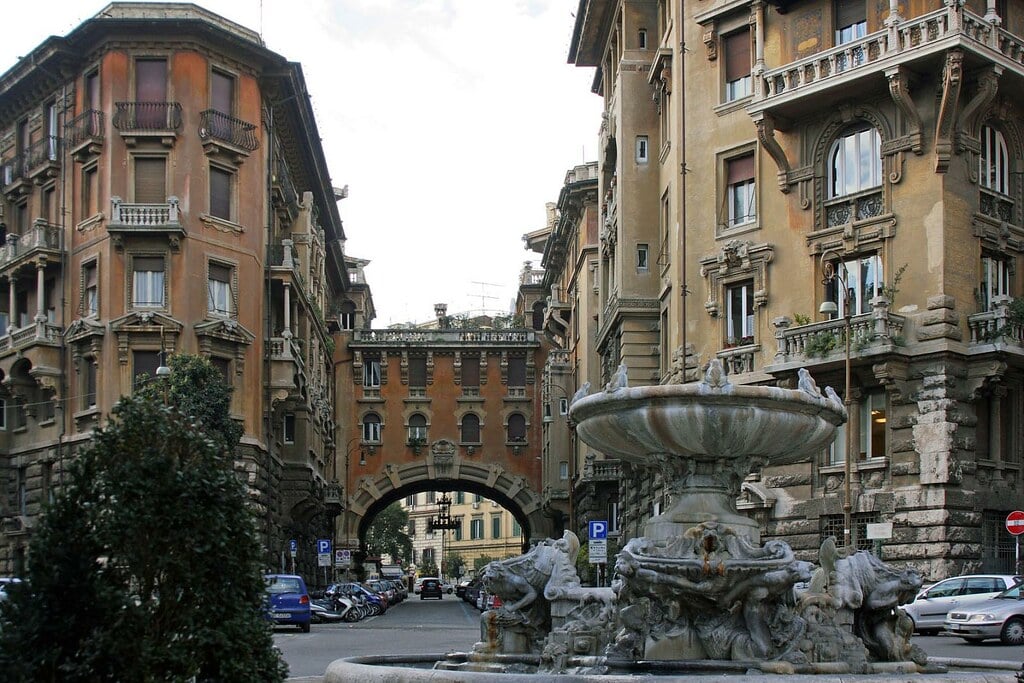
Coppedè neighbourhood in Rome
One of the most iconic elements of the district is the Frog Fountainlocated in the centre of Piazza Mincio, the district's main square. Its stone frogs, which give the fountain its name, and the surrounding buildings create an almost surreal atmosphere, seemingly taken from a fairy tale. Every detail, from the smallest decoration to the imposing facades of the buildings, has been conceived with a care and passion that reflect Coppedè's love of art and architecture.
Visit the Coppedè neighbourhood means immersing oneself in a unique atmosphere, where art is not confined to museums or galleries, but is an integral part of the urban space, liveable and tangible. This area offers a break from the hustle and bustle of the city, a place where time seems to slow down, allowing you to admire the beauty and imagination that only architecture can convey.
Despite its beauty and architectural importance, the Coppedè neighbourhood remains a hidden gem, a magical corner of Rome waiting to be discovered. For those looking for something different from the usual itineraries, a visit to this neighbourhood is an opportunity to explore an unusual and fascinating side of the city, where art merges with daily life in a continuous show of creativity.
People's Squarewith its vast opening surrounded by historical monuments and tree-lined avenues, serves as a grand gateway to the heart of Rome. This emblematic square is framed by three churches - Santa Maria dei Miracoli and Santa Maria in Montesanto at the sides and the Basilica di Santa Maria del Popolo at the northern entrance - creating an architectural ensemble of rare beauty and symmetry. At the centre towers theFlaminian obeliskan authentic Egyptian obelisk brought to Rome from Egypt by Augustus, which adds a touch of antiquity and mystery to the whole scene.
Over the centuries, the square has been the scene of public events, festivals and celebrations, evolving from a simple entrance to the city to a meeting place for Romans and tourists alike. Largely designed by Giuseppe Valadier in the early 19th century, the square today stands as a perfect example of neoclassical town planning, where each element is in harmony with the others, creating an ensemble that is both welcoming and imposing.
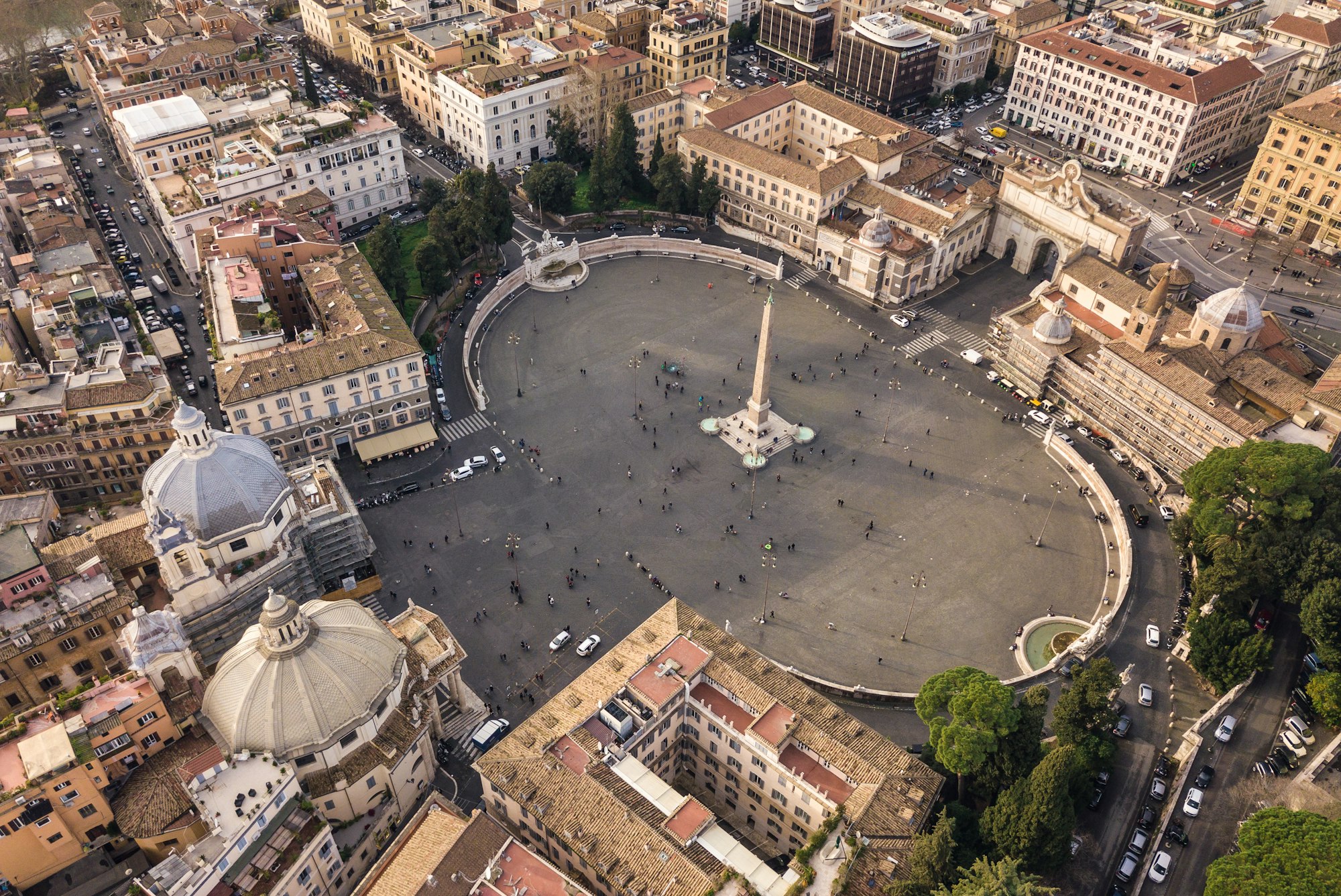
Aerial view of Piazza del Popolo in Rome
Le twin fountains of Piazza del Popolo, by Giovanni Ceccarini, and the People's Gatewhich welcomed visitors arriving from the Via Flaminia, are just some of the elements that enrich this urban space, making it one of the most photogenic and visited in Rome. The square is also the starting point for the famous Tridentformed by three of the city's chicest streets: Via del Babuino, Via del Corso and Via di Ripetta, leading to various artistic treasures and Roman shopping districts.
Visit People's Square means immersing oneself in the history and culture of Rome, having the opportunity to admire works of art, architecture and monuments that tell centuries of history. It is a place where the past and the present meet, offering visitors a unique perspective on life in the eternal city.
The Orange Gardenofficially known as Parco Savello, is a secret corner of peace and beauty located on the Aventine Hill, one of the seven hills on which Rome stands. This small garden, with its pathways, hidden benches and orange trees from which it takes its name, offers one of the most spectacular panoramic views of the city, especially at sunset when the sky is tinged with warm colours and the view extends from St Peter's Dome to the roofs and domes that characterise the Roman skyline.
The history of the garden is linked to the ancient Savelli family, who built their fortress here in the 13th century. Today, what remains is an oasis of tranquillity far from the hustle and bustle of the city, a place where Romans and tourists alike come to seek tranquillity, inspiration or simply a moment of reflection in front of the beauty of Rome.
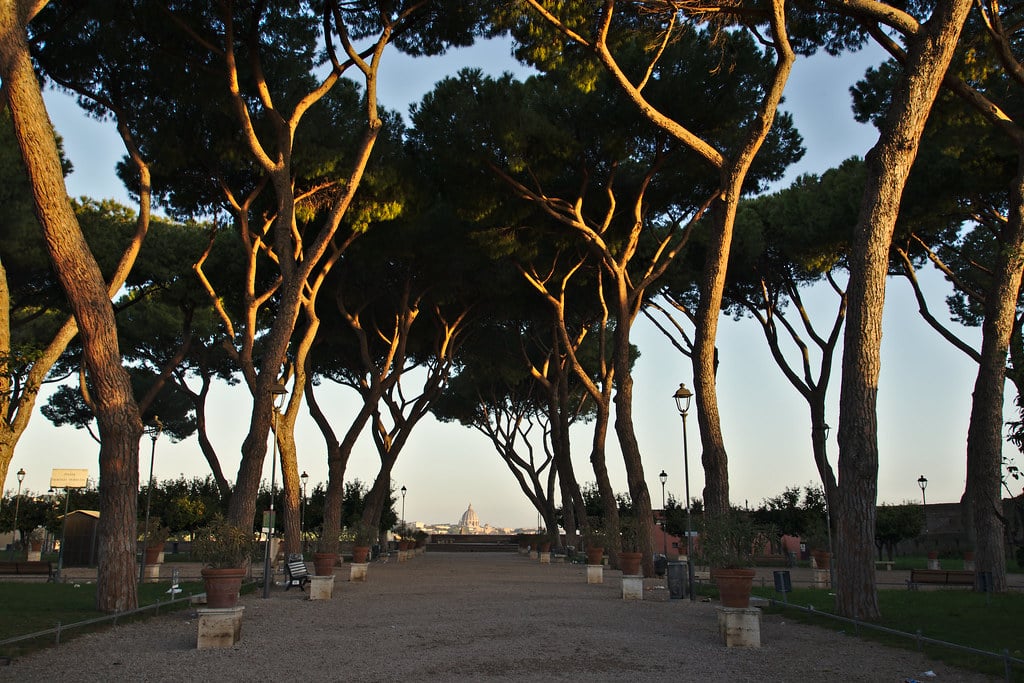
Orange Garden or Savello Park in Rome
The charm of Orange Garden lies not only in its view or in the tranquillity it offers, but also in its history and in the small details that enrich it, such as the striking Mascherone Fountaina 17th-century work, or the Basilica of St Sabinaone of the oldest examples of an early Christian church in Rome, which borders the garden.
This place is an invitation to slow down, to take a moment to admire the grandeur and at the same time the intimacy of Rome. The Orange Garden is an unmissable destination for those seeking a different view of the city, a place from which to observe the eternal beauty of Rome from a privileged perspective, immersed in the scent of orange trees and enveloped in the serenity of a garden that seems suspended in time.
Every corner of Rome tells a part of its long and fascinating history. From antiquity to the present day, the city has always had something new and wonderful to offer. To visit it is to embark on an unforgettable journey through time, discovering not only monuments and museums, but also hidden corners and lesser-known stories that make Rome truly eternal. No matter how many days you have available, Rome will always surprise you.
We are a young Web Agency with more than 10 years of experience, we love travelling and discovering new places, that is why we write every day on Italia Delight our travel site.

Italia Delight is your definitive guide to Italian restaurants, offering a comprehensive directory and web marketing services to enhance every dining experience. Discover, taste and connect with Italian tradition.
2024 G Tech Group S.R.L.S. - Via di Gagia 22,38086 Giustino (TN) - P.IVA 02743570224
Project in collaboration with Gianluca Gentile e Glocal Consulting
To provide the best experiences, we and our partners use technologies like cookies to store and/or access device information. Consenting to these technologies will allow us and our partners to process personal data such as browsing behavior or unique IDs on this site and show (non-) personalized ads. Not consenting or withdrawing consent, may adversely affect certain features and functions.
Click below to consent to the above or make granular choices. Your choices will be applied to this site only. You can change your settings at any time, including withdrawing your consent, by using the toggles on the Cookie Policy, or by clicking on the manage consent button at the bottom of the screen.